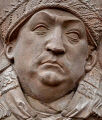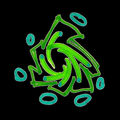Template:Selected anniversaries/February 1: Difference between revisions
No edit summary |
No edit summary |
||
| Line 2: | Line 2: | ||
File:Johannes Trithemius.jpg|link=Johannes Trithemius (nonfiction)|1462: Polymath [[Johannes Trithemius (nonfiction)|Johannes Trithemius]] born. He will be remembered as a lexicographer, chronicler, cryptographer, and occultist. | File:Johannes Trithemius.jpg|link=Johannes Trithemius (nonfiction)|1462: Polymath [[Johannes Trithemius (nonfiction)|Johannes Trithemius]] born. He will be remembered as a lexicographer, chronicler, cryptographer, and occultist. | ||
||1561: Henry Briggs born ... mathematician | ||1561: Mathematician and academic Henry Briggs born ... notable for changing the original logarithms invented by John Napier into common (base 10) logarithms, which are sometimes known as Briggsian logarithms in his honor. DOB unknown. Pic search (none?): https://www.google.com/search?q=henry+briggs+mathematician | ||
||1698: Mathematician Colin Maclaurin born. He will make important contributions to geometry and algebra. The Maclaurin series, a special case of the Taylor series, will be named after him. Pic. | ||1698: Mathematician Colin Maclaurin born. He will make important contributions to geometry and algebra. The Maclaurin series, a special case of the Taylor series, will be named after him. Pic. | ||
| Line 8: | Line 8: | ||
File:Charles Camus - Cours de mathématique.jpg|link=Charles Étienne Louis Camus (nonfiction)|1767: Mathematician and crime-fighter [[Charles Étienne Louis Camus (nonfiction)|Charles Étienne Louis Camus]] publishes updated edition of ''Cours de mathématiques'' with new section on the detection and prevention of [[crimes against mathematical constants]]. | File:Charles Camus - Cours de mathématique.jpg|link=Charles Étienne Louis Camus (nonfiction)|1767: Mathematician and crime-fighter [[Charles Étienne Louis Camus (nonfiction)|Charles Étienne Louis Camus]] publishes updated edition of ''Cours de mathématiques'' with new section on the detection and prevention of [[crimes against mathematical constants]]. | ||
||1840: William Allen Whitworth born ... mathematician and a priest in the Church of England. | ||1840: William Allen Whitworth born ... mathematician and a priest in the Church of England. Author of "Choice and Chance". Pic search (book cover): https://www.google.com/search?q=William+Allen+Whitworth | ||
||1847: Eduardo Torroja Caballé born ... mathematician. Pic. | ||1847: Eduardo Torroja Caballé born ... mathematician. Pic. | ||
| Line 24: | Line 24: | ||
File:George Gabriel Stokes.jpg|link=Sir George Stokes, 1st Baronet (nonfiction)|1903: Physicist and mathematician [[Sir George Stokes, 1st Baronet (nonfiction)|Sir George Stokes, 1st Baronet]] dies. He made seminal contributions to fluid dynamics (including the Navier–Stokes equations) and to physical optics. | File:George Gabriel Stokes.jpg|link=Sir George Stokes, 1st Baronet (nonfiction)|1903: Physicist and mathematician [[Sir George Stokes, 1st Baronet (nonfiction)|Sir George Stokes, 1st Baronet]] dies. He made seminal contributions to fluid dynamics (including the Navier–Stokes equations) and to physical optics. | ||
||1905: Emilio G. Segrè born ... physicist and academic, Nobel Prize laureate. | ||1905: Emilio G. Segrè born ... physicist and academic, Nobel Prize laureate. Pic. | ||
||1905: Ernst Carl Gerlach Stueckelberg born ... mathematician and physicist, regarded as one of the most eminent physicists of the 20th century. Despite making key advances in theoretical physics, including the exchange particle model of fundamental forces, causal S-matrix theory, and the renormalization group, his idiosyncratic style and publication in minor journals led to his work being unrecognized until the mid-1990s. Pic. | ||1905: Ernst Carl Gerlach Stueckelberg born ... mathematician and physicist, regarded as one of the most eminent physicists of the 20th century. Despite making key advances in theoretical physics, including the exchange particle model of fundamental forces, causal S-matrix theory, and the renormalization group, his idiosyncratic style and publication in minor journals led to his work being unrecognized until the mid-1990s. Pic. | ||
||1907: Léon Serpollet dies ... industrialist and pioneer of steam automobiles, under the Gardner-Serpollet brand. | ||1907: Léon Serpollet dies ... industrialist and pioneer of steam automobiles, under the Gardner-Serpollet brand. Pic. | ||
||1907: Melba Newell Phillips born ... physicist and pioneer science educator. | ||1907: Melba Newell Phillips born ... physicist and pioneer science educator. Pic. | ||
||1908: George Pal born ... animator and producer. | ||1908: George Pal born ... animator and producer. Pic. | ||
||1911: Abraham Haskel Taub born ... mathematician and physicist, well known for his important contributions to the early development of general relativity, as well as differential geometry and differential equations. | ||1911: Abraham Haskel Taub born ... mathematician and physicist, well known for his important contributions to the early development of general relativity, as well as differential geometry and differential equations. Pic. | ||
||1916: George Whitelaw Mackey born ... mathematician. Mackey was one of the pioneer workers in the intersection of quantum logic, the theory of infinite-dimensional unitary representations of groups, the theory of operator algebras and noncommutative geometry. Pic. | ||1916: George Whitelaw Mackey born ... mathematician. Mackey was one of the pioneer workers in the intersection of quantum logic, the theory of infinite-dimensional unitary representations of groups, the theory of operator algebras and noncommutative geometry. Pic. | ||
| Line 48: | Line 48: | ||
||1952: Roger Yonchien Tsien born ... biochemist and academic. He was awarded the 2008 Nobel Prize in Chemistry for his discovery and development of the green fluorescent protein, in collaboration with organic chemist Osamu Shimomura and neurobiologist Martin Chalfie. Pic. | ||1952: Roger Yonchien Tsien born ... biochemist and academic. He was awarded the 2008 Nobel Prize in Chemistry for his discovery and development of the green fluorescent protein, in collaboration with organic chemist Osamu Shimomura and neurobiologist Martin Chalfie. Pic. | ||
||1958: Clinton Davisson dies ... physicist and academic, Nobel Prize laureate. | ||1958: Clinton Davisson dies ... physicist and academic, Nobel Prize laureate ... discovery of electron diffraction in the famous Davisson-Germer experiment. Pic. | ||
||1964: William Howard Livens dies ... engineer, a soldier in the British Army and an inventor particularly known for the design of chemical warfare and flame warfare weapons. Resourceful and clever, Livens’ successful creations were characterised by being very practical and easy to produce in large numbers. Livens is best known for inventing the Livens Projector, a simple mortar-like weapon that could throw large drums filled with inflammable or toxic chemicals. Pic. | ||1964: William Howard Livens dies ... engineer, a soldier in the British Army and an inventor particularly known for the design of chemical warfare and flame warfare weapons. Resourceful and clever, Livens’ successful creations were characterised by being very practical and easy to produce in large numbers. Livens is best known for inventing the Livens Projector, a simple mortar-like weapon that could throw large drums filled with inflammable or toxic chemicals. Pic. | ||
||1970: Alfréd Rényi dies ... mathematician and academic. | ||1970: Alfréd Rényi dies ... mathematician and academic. Pic search yes: https://www.google.com/search?q=alfréd+rényi&oq=Alfréd+Rényi | ||
File:Werner Heisenberg.jpg|link=Werner Heisenberg (nonfiction)|1976: Physicist and academic [[Werner Heisenberg (nonfiction)|Werner Heisenberg]] dies. He introduced the [[Uncertainty principle (nonfiction)|uncertainty principle]] -- in quantum mechanics, any of a variety of mathematical inequalities asserting a fundamental limit to the precision with which certain pairs of physical properties of a particle can be known. | File:Werner Heisenberg.jpg|link=Werner Heisenberg (nonfiction)|1976: Physicist and academic [[Werner Heisenberg (nonfiction)|Werner Heisenberg]] dies. He introduced the [[Uncertainty principle (nonfiction)|uncertainty principle]] -- in quantum mechanics, any of a variety of mathematical inequalities asserting a fundamental limit to the precision with which certain pairs of physical properties of a particle can be known. | ||
| Line 58: | Line 58: | ||
File:Bertram Kostant.jpg|link=Bertram Kostant (nonfiction)|1976: Mathematician [[Bertram Kostant (nonfiction)|Bertram Kostant]] uses geometric quantization to detect and record the electroquantum afterlife of [[Werner Heisenberg (nonfiction)|Werner Heisenberg]]. | File:Bertram Kostant.jpg|link=Bertram Kostant (nonfiction)|1976: Mathematician [[Bertram Kostant (nonfiction)|Bertram Kostant]] uses geometric quantization to detect and record the electroquantum afterlife of [[Werner Heisenberg (nonfiction)|Werner Heisenberg]]. | ||
||1981: Donald Wills Douglas, Sr. dies ... engineer and businessman, founded the Douglas Aircraft Company. | ||1981: Donald Wills Douglas, Sr. dies ... engineer and businessman, founded the Douglas Aircraft Company. Pic. | ||
||1992: The Chief Judicial Magistrate of Bhopal court declares Warren Anderson, ex-CEO of Union Carbide, a fugitive under Indian law for failing to appear in the Bhopal disaster case. | ||1992: The Chief Judicial Magistrate of Bhopal court declares Warren Anderson, ex-CEO of Union Carbide, a fugitive under Indian law for failing to appear in the Bhopal disaster case. | ||
||1992: Frank Ludvig Spitzer dies ... mathematician who made fundamental contributions to probability theory, including the theory of random walks, fluctuation theory, percolation theory, the Wiener sausage, and especially the theory of interacting particle systems. Rare among mathematicians, he chose to focus broadly on "phenomena", rather than any one of the many specific theorems that might help to articulate a given phenomenon. | ||1992: Frank Ludvig Spitzer dies ... mathematician who made fundamental contributions to probability theory, including the theory of random walks, fluctuation theory, percolation theory, the Wiener sausage, and especially the theory of interacting particle systems. Rare among mathematicians, he chose to focus broadly on "phenomena", rather than any one of the many specific theorems that might help to articulate a given phenomenon. Pic. | ||
||2003: Space Shuttle Columbia disintegrates during the reentry of mission STS-107 into the Earth's atmosphere, killing all seven astronauts aboard. | ||2003: Space Shuttle Columbia disintegrates during the reentry of mission STS-107 into the Earth's atmosphere, killing all seven astronauts aboard. | ||
Revision as of 04:37, 1 February 2019
1462: Polymath Johannes Trithemius born. He will be remembered as a lexicographer, chronicler, cryptographer, and occultist.
1767: Mathematician and crime-fighter Charles Étienne Louis Camus publishes updated edition of Cours de mathématiques with new section on the detection and prevention of crimes against mathematical constants.
1893: Thomas A. Edison finishes construction of the first motion picture studio, the Black Maria in West Orange, New Jersey.
1903: Physicist and mathematician Sir George Stokes, 1st Baronet dies. He made seminal contributions to fluid dynamics (including the Navier–Stokes equations) and to physical optics.
1934: Mathematician, philosopher, and crime-fighter Imre Lakatos uses his thesis of the fallibility of mathematics and its 'methodology of proofs and refutations' in its pre-axiomatic stages of development to detect and prevent crimes against mathematical constants.
1944: Pultizer Prize awarded to Field Report Number One (Peenemunde edition).
1976: Physicist and academic Werner Heisenberg dies. He introduced the uncertainty principle -- in quantum mechanics, any of a variety of mathematical inequalities asserting a fundamental limit to the precision with which certain pairs of physical properties of a particle can be known.
1976: Mathematician Bertram Kostant uses geometric quantization to detect and record the electroquantum afterlife of Werner Heisenberg.
2017: Chromatographic analysis of Blue Green Spiral reveals previously unknown color "midway between blue and green."








